 |
 |
 |
| |
Albuferon Once Every 2 or 4 Weeks Interferon Looks Good in Phase 2 Study
|
| |
| |
Reported by Jules Levin
EASL, April 11-15, 2007, Barcelona
"HUMAN GENOME SCIENCES REPORTS POSITIVE INTERIM RESULTS OF PHASE 2B TRIAL OF ALBUFERON'
Press release from Human Genome Sciences
- Albuferon 900-mcg dosed every two weeks achieved an SVR12 rate of 59% vs. 54% for Pegasys dosed every week (ITT analysis), as well as more favorable quality-of-life scores -
- All Albuferon doses provided efficacy at least comparable to Pegasys -
- Efficacy was enhanced in all Albuferon doses vs. Pegasys in treatment-adherent patients -
- Encouraging results for monthly dosing regimen -
pictures of slides at bottom of report.
Authors conclude: all alb-IFN treatment regimens provided efficacy at least comparable to Peg-Ifna-2a. All alb-IFN treatment regimens showed less impairment of quality of life as measured by SF-36. Patients receiving 1200 ug every 2 weeks (Q2w) may require dose titration according to individual patient tolerance. Both the 900 ug Q2w and 1200 ug Q2w doses of alb-IFN are being evaluated in a Phase 3 clinical program. Once monthly dosing of alb-IFN deserves further evaluation.
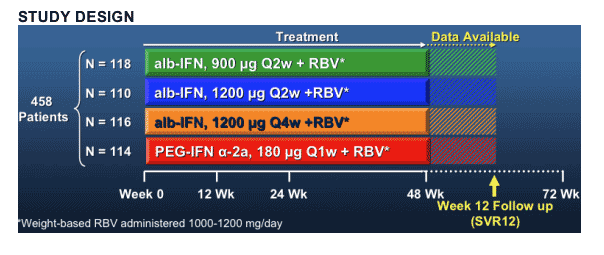
ROCKVILLE, Maryland - April 14, 2007 - Human Genome Sciences, Inc. (NASDAQ: HGSI) today reported results at Week 12 following the completion of therapy ( SVR12) in a Phase 2b clinical trial of Albuferon (albinterferon alfa-2b) in combination with ribavirin in patients with genotype 1 chronic hepatitis C who are na´ve to interferon alpha-based treatment regimens. The results were presented over the weekend in Barcelona at the 42 nd Annual Meeting of the European Association for the Study of the Liver (EASL).
"The interim data presented at EASL suggest that Albuferon may offer efficacy at least comparable to peginterferon alfa-2a, with half the injections and the potential for less impairment of quality of life," said Stefan Zeuzem, M.D., Professor of Medicine and Chief, Department of Medicine, J.W. Goethe University Hospital ( Frankfurt, Germany), and a clinical investigator in the Phase 2b trial. "We look forward to continuing the evaluation of Albuferon in larger populations in Phase 3 trials."
The interim results of the Phase 2b trial demonstrated that Albuferon provided at least comparable efficacy vs. Pegasys. The treatment group receiving Albuferon 900-mcg doses every two weeks achieved a 59% rate of sustained virologic response at 12 weeks following completion of therapy ( SVR 12), vs. 54% for Pegasys administered once every week ( ITT analysis). This Albuferon treatment group also had more favorable health-related quality-of-life scores than the Pegasys treatment group. All Albuferon doses provided efficacy at least comparable to Pegasys. Among treatment-adherent patients, 73% of those in the combined groups receiving Albuferon every two weeks achieved SVR 12, versus 63% for patients receiving Pegasys once a week.
Interim Results by Treatment Group
The interim results of the Phase 2b trial at Week 12 following the completion of therapy include the following virologic response rates (SVR12) and other findings:
Albuferon 900-mcg Every Two Weeks (Albuferon 900 Q2)
* Based on an intention-to-treat ( ITT) analysis, 59% of patients in the Albuferon 900 Q2 treatment group achieved SVR12, vs. 54% for Pegasys administered every week.
* Among treatment-adherent patients, 74% of those in the Albuferon 900 Q2 treatment group achieved SVR 12, versus 63% for Pegasys.
* In heavier patients ( >75 kg) who were treatment-adherent, 81% of those in the Albuferon 900 Q2 treatment group achie ved SVR 12, versus 57% for Pegasys.
* Based on the SF-36 Heath Survey, patients in the Albuferon 900 Q2 treatment group reported less impairment of health-related quality of life, compared with patients in the Pegasys treatment group, as measured by both physical component and mental component SF-36 summary measures at all time-points throughout the 48-week treatment period.
* At Weeks 12 and 24, fewer working patients in the Albuferon 900 Q2 treatment group reported missing 7 days or more of work during the previous month, vs. the Pegasys group (Week 12: 4% for Albuferon 900 Q2 vs. 17% for Pegasys; Week 24: 5% for Albuferon 900 Q2, vs. 22% for Pegasys).
* The rate of discontinuations due to adverse events was 9% in the Albuferon 900 Q2 treatment group, vs. 6% in the Pegasys group.
"The 900-mcg Albuferon dose has the potential to offer patients an attractive therapeutic option, given the favorable antiviral response data, more favorable quality of life effects, and half as many injections," said David C. Stump, M.D., Executive Vice President, Research and Development, HGS.
Albuferon 1200-mcg Every Two Weeks (Albuferon 1200 Q2)
* ITT analysis shows that 56% of patients in the Albuferon 1200 Q2 treatment group achieved SVR12, vs. 54% for Pegasys administered every week.
* Among treatment-adherent patients, 72% of those in the Albuferon 1200 Q2 treatment group achieved SVR 12, versus 63% for Pegasys.
* In heavier patients ( >75 kg) who were treatment-adherent, 70% of those in the Albuferon 1200 Q2 treatment group achie ved SVR 12, versus 57% for Pegasys every week.
* ITT analysis shows that the Albuferon 1200 Q2 treatment group exhibited a robust early antiviral response (reduction in hepatitis C RNA viral load to below the level of quantitation): 75% for Albuferon 1200 Q2 at Week 12, vs. 66% for Pegasys. The Albuferon 1200 Q2 treatment group also had the most rapid time to HCV RNA negativity.
* The rate of discontinuations due to adverse events was 19% in the Albuferon 1200 Q2 treatment group, vs. 6% in the Pegasys group. Adverse events observed were those typically expected with interferon therapy. Dose reductions were attempted in only 29% of subjects prior to discontinuation, versus 43% for Pegasys.
"In the Albuferon Phase 3 trials, we will strongly encourage titration of dose where necessary to ensure tolerability and maximize the therapeutic benefit of the robust early antiviral response offered by the 1200-microgram dose on a two-week administration schedule," said Dr. Stump.
Albuferon 1200-mcg Every Four Weeks (Albuferon 1200 Q4)
* ITT analysis shows that 53% of patients in the Albuferon 1200 Q4 treatment group achieved SVR12, vs. 54% for Pegasys administered every week.
* Among treatment-adherent patients, 68% of those in the Albuferon 1200 Q4 treatment group achieved SVR 12, versus 63% for Pegasys.
* In heavier patients ( >75 kg) who were treatment-adherent, 67% of those in the Albuferon 1200 Q4 treatment group achie ved SVR 12, versus 57% for Pegasys administered once every week.
* The rate of discontinuations due to adverse events was 12% in the Albuferon 1200 Q4 treatment group, vs. 6% in the Pegasys group. Dose reductions due to hematologic adverse events were lowest in the group receiving 1200-mcg Albuferon every four weeks (6% vs. 23% for Pegasys).
"We are encouraged that Albuferon 1200-mcg dosed monthly achieved comparable efficacy vs. Pegasys despite lower early virologic response," said Dr. Stump. "We and our collaborator, Novartis, are currently planning an additional study to identify the optimal dose for Albuferon dosed monthly."
The interim Phase 2b results presented at EASL on Saturday, April 14 (Zeuzem S, Benhamou Y, Bain V, McHutchison J, et al), include data available through Week 12 following completion of 48 weeks of therapy for 458 patients who were enrolled in the randomized, open-label, multi-center, active-controlled, dose-ranging trial. The study was conducted in Australia, Canada, Czech Republic, France, Germany, Israel, Poland and Romania. Patients were randomized into four treatment groups, three of which received subcutaneously administered Albuferon (900 mcg every two weeks, 1200 mcg every two weeks, and 1200 mcg every four weeks). The fourth treatment group serves as the active control group and received 180-mcg doses of subcutaneously administered peginterferon alfa-2a (Pegasys) once a week. All patients received weight-based oral ribavirin daily. The primary efficacy endpoint is sustained virologic response (SVR), defined as undetectable viral load (HCV RNA<10 IU/mL) at 24 weeks following completion of therapy. Interim results at Week 12 following completion of therapy are regarded as highly predictive of SVR.
Interim Results of Phase 2 Trial in Genotype 2 or 3 Chronic Hepatitis C
An additional presentation at EASL reported the interim results at Week 12 following the completion of therapy ( SVR12) in a randomized Phase 2 trial of Albuferon in combination with ribavirin in 43 treatment-na´ve patients with genotype 2 or 3 chronic hepatitis C ( CHC). The interim results demonstrated that Albuferon dosed at 1500 mcg every four weeks was well tolerated and exhibited robust antiviral activity in these patients. Dose reductions due to hematologic adverse events stabilized by Week 8 and recovered upon completion of therapy. These results support additional evaluation of Albuferon in combination with ribavirin in a Phase 3 trial in patients with genotypes 2 and 3 CHC. The results also support further evaluation of Albuferon at higher doses with monthly administration.
About Albuferon
Albuferon is a novel long-acting form of interferon alpha created by HGS using its proprietary albumin fusion technology. Albuferon results from the genetic fusion of human albumin and interferon alpha. Human albumin is the most prevalent naturally occurring blood protein in the human circulatory system, persisting in circulation in the body for over twenty days. Research has shown that genetic fusion of therapeutic proteins to human albumin decreases clearance and prolongs the half-life of the proteins. Recombinant interferon alpha is approved for the treatment of hepatitis C, hepatitis B and a broad range of cancers.
Albuferon is being developed by HGS and Novartis under an exclusive worldwide development and commercialization agreement entered into in June 2006. Under the agreement, HGS and Novartis will co-commercialize Albuferon in the United States, and will share clinical development costs, U.S. commercialization costs and U.S. profits equally. Novartis will be responsible for commercialization in the rest of the world and will pay HGS a royalty on those sales. Clinical development, commercial milestone and other payments to HGS could total as much as $507.5 million, including $92.5 million received to date.
About Hepatitis C
Hepatitis C is an inflammation of the liver caused by the hepatitis C virus. It is estimated that as many as 170 million people worldwide are infected with hepatitis C virus. This includes nearly four million people in the United States. When detectable levels of the hepatitis C virus in the blood persist for at least six months, a person is diagnosed as having chronic hepatitis C. The hepatitis C virus can cause serious liver disease in a significant proportion of infected individuals, leading to cirrhosis, primary liver cancer, and even death.
About Human Genome Sciences
The mission of HGS is to apply great science and great medicine to bring innovative drugs to patients with unmet medical needs.
The HGS clinical development pipeline includes novel drugs to treat hepatitis C, lupus, anthrax disease, cancer, rheumatoid arthritis and HIV/AIDS. The Company's primary focus is rapid progress toward the commercialization of its two lead compounds, Albuferon for hepatitis C, and LymphoStat-B for lupus. Phase 3 clinical trials of both compounds are now underway.
In June 2006, HGS announced that the U.S. Government exercised its option under an existing contract to purchase 20,000 doses of ABthrax for the treatment of anthrax disease. Other HGS drugs in clinical development include two TRAIL receptor antibodies for the treatment of hematopoietic and solid malignancies, in addition to an antibody to the CCR5 receptor for the treatment of HIV/AIDS.
For more information about HGS, please visit the Company's web site at www.hgsi.com. For more information about Albuferon, or to download copies of the EASL presentations please visit http://www.hgsi.com/products/albuferon.html. To view the presentation of interim results of the Phase 2b trial of Albuferon in treatment-na´ve genotype 1 hepatitis C patients, click here. To view the presentation of interim results of the Phase 2 trial of Albuferon in treatment-na´ve genotype 2 or 3 hepatitis C patients, click here. Health professionals or patients interested in Albuferon clinical trials or other studies involving HGS products may inquire via the Contact Us section of the Company's web site, www.hgsi.com/products/request.html, or by calling us at (301) 610-5790, extension 3550.
HGS, Human Genome Sciences, ABthrax, Albuferon and LymphoStat-B are trademarks of Human Genome Sciences, Inc.
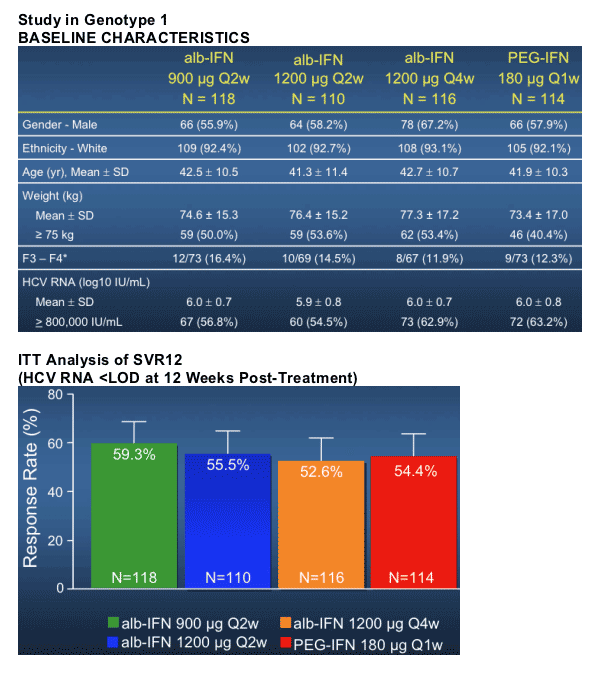
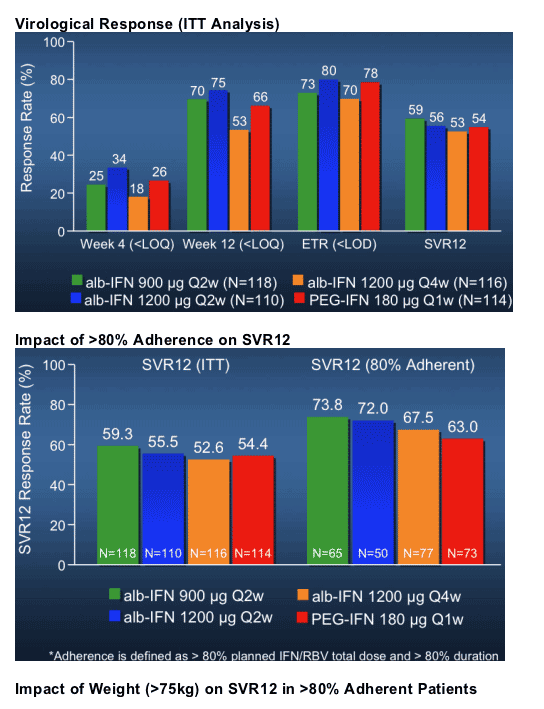
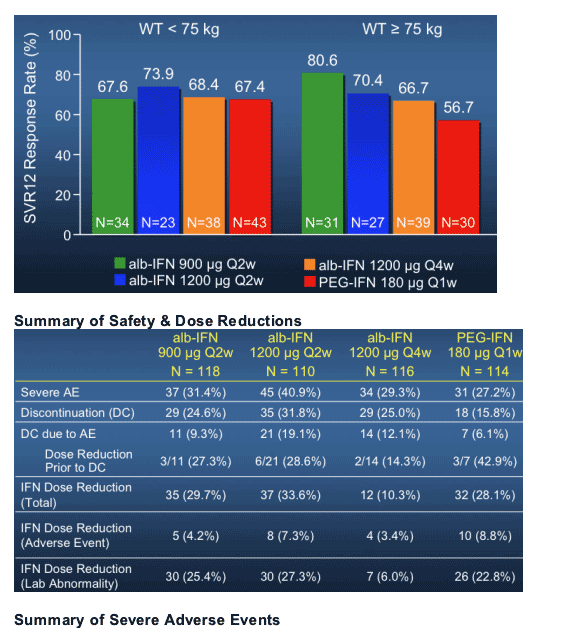
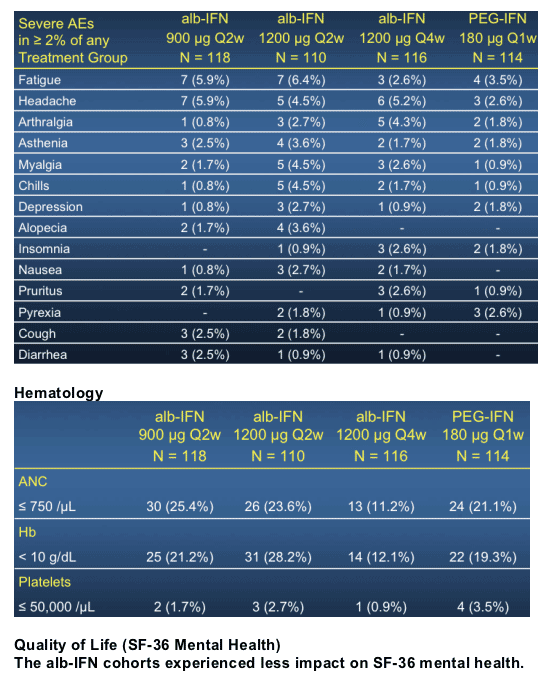
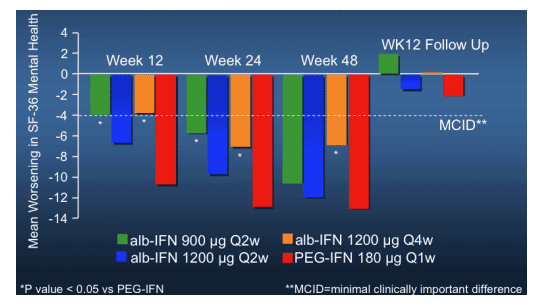
|
| |
|
 |
 |
|
|